by Alan Dworsky and Betsy Sansby
Illustrations by Robert Jackson
Cover Art by Marie Olofsdotter
Dancing Hands Music
'A goldmine" - DRUM Magazine
The book is masterfully written. It's like having a good friend sitting next to you, guiding you through each lesson. It explains musical concepts in a way anyone can easily understand. The sections on cross rhythms and polyrhythms should be required reading for any musician!"
- Professor Michael Williams, Department of Music, Winthrop University


For Jerry Sansby, the first drummer in the family
 ,e would like to express our gratitude to all our teachers, especially Marc Anderson, who generously shared his knowledge of Ghanaian rhythms with love and reverence for the culture that created them. We'd also like to thank those who have taught us through their books and videos, especially David Locke (for his clear presentation and analysis of Ghanaian rhythms), Phil Maturano (for his organization of patterns and his concept of "relayed time shifting," which we adapted into our lesson on bending a pattern), Reinhard Flatischler (whose Ta Ke Ti Na method we adapted into rhythm walking), and Gordy Knudtson (from whom we learned - both in his books and in private lessons - a wide variety of cross-rhythms and other patterns, as well as the method we call "say-it-and-play-it"). We are,also indebted to the creators of all the other sources listed at the back of this book and to all the unknown creators of the rhythms of the world.
,e would like to express our gratitude to all our teachers, especially Marc Anderson, who generously shared his knowledge of Ghanaian rhythms with love and reverence for the culture that created them. We'd also like to thank those who have taught us through their books and videos, especially David Locke (for his clear presentation and analysis of Ghanaian rhythms), Phil Maturano (for his organization of patterns and his concept of "relayed time shifting," which we adapted into our lesson on bending a pattern), Reinhard Flatischler (whose Ta Ke Ti Na method we adapted into rhythm walking), and Gordy Knudtson (from whom we learned - both in his books and in private lessons - a wide variety of cross-rhythms and other patterns, as well as the method we call "say-it-and-play-it"). We are,also indebted to the creators of all the other sources listed at the back of this book and to all the unknown creators of the rhythms of the world.
Finally, we would like to thank Mamady Keita, who has taught us through his recordings, and whose brilliant djembe playing has been an unending source of inspiration and delight.
 i his book is a roadmap to rhythm for any musician. It's for guitar players intrigued by the rhythms of world music. It's for keyboard players who've studied scales and chords and now want to study rhythm in a systematic way. It's for drummers, bass players, and sax players who want to groove and solo with a deeper understanding of rhythmic structure. Whatever your instrument, if you want to play funkier and don't mind using your head to do it, this book is for you.
i his book is a roadmap to rhythm for any musician. It's for guitar players intrigued by the rhythms of world music. It's for keyboard players who've studied scales and chords and now want to study rhythm in a systematic way. It's for drummers, bass players, and sax players who want to groove and solo with a deeper understanding of rhythmic structure. Whatever your instrument, if you want to play funkier and don't mind using your head to do it, this book is for you.
The patterns in this book come from African and Afro-Cuban rhythms, the source for the groove in most contemporary music. But our purpose here is not to teach any specific style of drumming. Our purpose is to illuminate the subject of rhythm in general so you'll be able to navigate comfortably in any rhythmic territory.
To do that, we've organized representative patterns according to their structure, arranged them roughly in order of difficulty, and presented them in bite-sized lessons. While we present the patterns, we also present rhythmic concepts and techniques you can use to create patterns of your own. And we include plenty of examples of how patterns can be varied and combined when you improvise or solo.
We've tried to make this book as user-friendly as possible. For example, we use big, easy-to-read charts that are so simple even non-musicians can understand them. Any time we introduce a new concept or technique, we highlight it in the margin for easy reference. Any time we introduce a new term, we put it in bold letters, define it on the spot, and add it to the glossary at the back of the book. We've also included some blank charts you can photocopy and use to write down patterns of your own. We've even used a special binding that makes the book stay open without the help of a shoe.
The CD that comes with this book helps create a realistic, threedimensional rhythmic context for you to play in right from the start. It contains two reference rhythms you'll be playing with while you practice. Each of those rhythms is recorded for about five minutes at each of seven different speeds so you can practice at your own level. And as soon as you feel like putting your instrument aside and using your whole body to learn the patterns, check out the chapter on rhythm walking.
From time to time, we tell you that a pattern comes from a particular African or Afro-Cuban rhythm. We do this to acknowledge our sources where we know the name of a rhythm and as a reminder that the patterns in this book aren't just mathematical abstractions. But just because we say a pattern can be found in a particular rhythm, it doesn't mean the pattern can be found only there. Most of the patterns in this book are found in many rhythmic traditions around the world and many can be heard in rock, funk, jazz, and other contemporary styles.
We hope this book will help you express yourself better in the language of rhythm and inspire you to delve deeper into the world of African and Afro-Cuban rhythms. At the back of the book, we've included a list of sources for further study and a list of CDs of great drumming from around the world. But don't stop there. Look for opportunities to experience the real thing by going to concerts, taking lessons, or joining an ensemble. There's no substitute for the direct experience of these magnificent rhythms.
 n this chapter, while we explain how to read the charts we'll also be explaining the basic concepts you need to know to start working your way through this book. If any of the concepts seem confusing at first, don't worry. They'll all become clearer as you begin using them in the coming lessons.
n this chapter, while we explain how to read the charts we'll also be explaining the basic concepts you need to know to start working your way through this book. If any of the concepts seem confusing at first, don't worry. They'll all become clearer as you begin using them in the coming lessons.
Because we're mainly interested in teaching the fundamentals of rhythmic structure, we're going to focus on just two variables of rhythm: 1) when sounds occur, and 2) what the sounds are. To notate these two variables, we use box charts instead of standard music notation because for our purposes they're simpler and clearer.

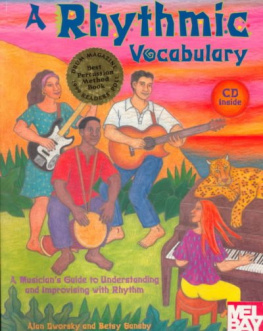
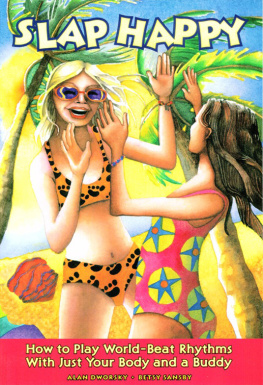
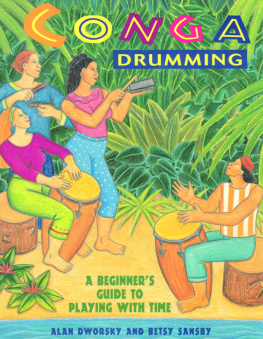
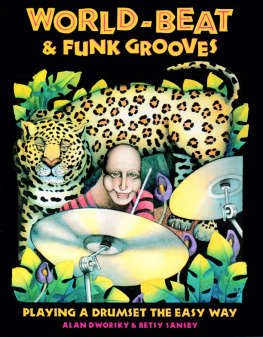

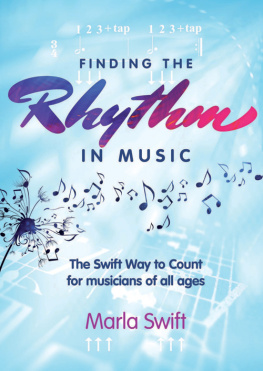

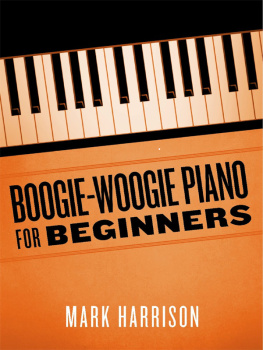
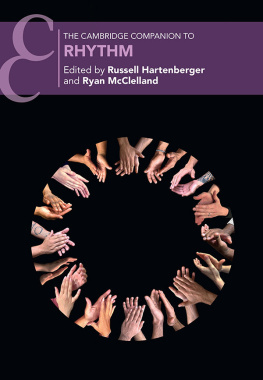
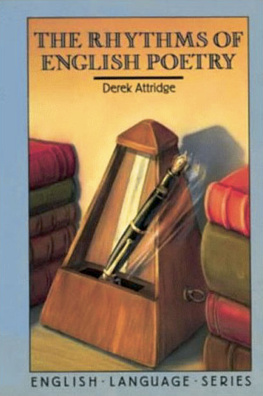
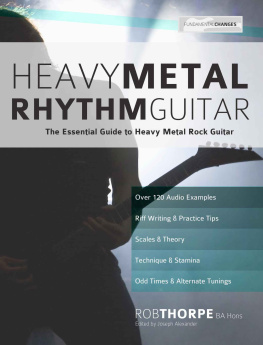
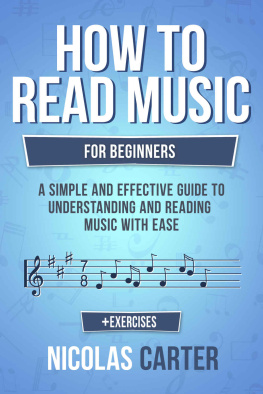
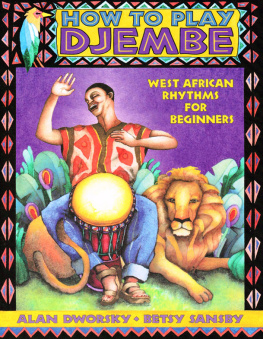





 ,e would like to express our gratitude to all our teachers, especially Marc Anderson, who generously shared his knowledge of Ghanaian rhythms with love and reverence for the culture that created them. We'd also like to thank those who have taught us through their books and videos, especially David Locke (for his clear presentation and analysis of Ghanaian rhythms), Phil Maturano (for his organization of patterns and his concept of "relayed time shifting," which we adapted into our lesson on bending a pattern), Reinhard Flatischler (whose Ta Ke Ti Na method we adapted into rhythm walking), and Gordy Knudtson (from whom we learned - both in his books and in private lessons - a wide variety of cross-rhythms and other patterns, as well as the method we call "say-it-and-play-it"). We are,also indebted to the creators of all the other sources listed at the back of this book and to all the unknown creators of the rhythms of the world.
,e would like to express our gratitude to all our teachers, especially Marc Anderson, who generously shared his knowledge of Ghanaian rhythms with love and reverence for the culture that created them. We'd also like to thank those who have taught us through their books and videos, especially David Locke (for his clear presentation and analysis of Ghanaian rhythms), Phil Maturano (for his organization of patterns and his concept of "relayed time shifting," which we adapted into our lesson on bending a pattern), Reinhard Flatischler (whose Ta Ke Ti Na method we adapted into rhythm walking), and Gordy Knudtson (from whom we learned - both in his books and in private lessons - a wide variety of cross-rhythms and other patterns, as well as the method we call "say-it-and-play-it"). We are,also indebted to the creators of all the other sources listed at the back of this book and to all the unknown creators of the rhythms of the world.


 i his book is a roadmap to rhythm for any musician. It's for guitar players intrigued by the rhythms of world music. It's for keyboard players who've studied scales and chords and now want to study rhythm in a systematic way. It's for drummers, bass players, and sax players who want to groove and solo with a deeper understanding of rhythmic structure. Whatever your instrument, if you want to play funkier and don't mind using your head to do it, this book is for you.
i his book is a roadmap to rhythm for any musician. It's for guitar players intrigued by the rhythms of world music. It's for keyboard players who've studied scales and chords and now want to study rhythm in a systematic way. It's for drummers, bass players, and sax players who want to groove and solo with a deeper understanding of rhythmic structure. Whatever your instrument, if you want to play funkier and don't mind using your head to do it, this book is for you.

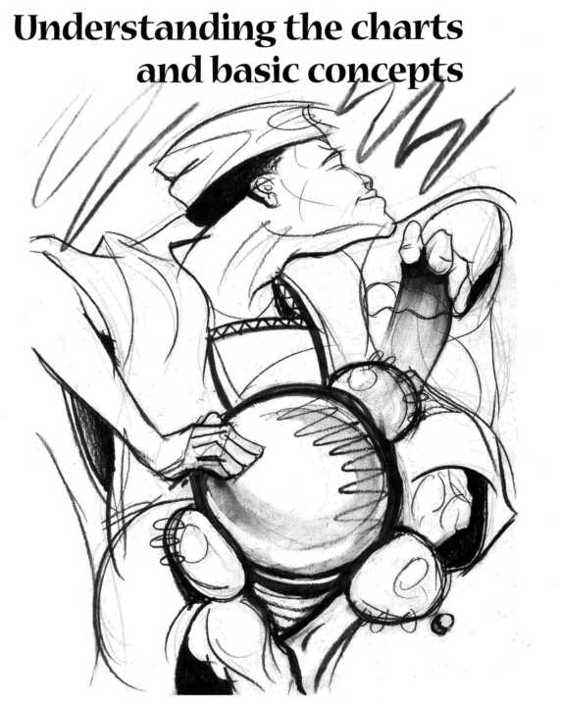
 n this chapter, while we explain how to read the charts we'll also be explaining the basic concepts you need to know to start working your way through this book. If any of the concepts seem confusing at first, don't worry. They'll all become clearer as you begin using them in the coming lessons.
n this chapter, while we explain how to read the charts we'll also be explaining the basic concepts you need to know to start working your way through this book. If any of the concepts seem confusing at first, don't worry. They'll all become clearer as you begin using them in the coming lessons.